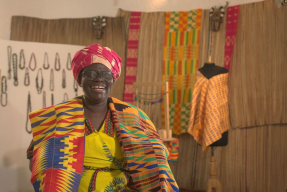
She looked at me very sternly, as if I had said something wrong. I knew that her students must be very obedient because she was arguably the most intimidating teacher I had met in a post-soviet country, and I had met a lot of them. Rosa, as she wanted me to call her, even though it wasn’t her name, was a teacher in a secondary school.
“You must, um, understand Sam,” she started out, as if trying to figure out how to word her sentences correctly in English, “Tajikistan today, is not all of the land of Tajiks. Samarkand and Bukhara are also part of the wider land of Tajiks.”
“Ok Rosa,” I began to respond, “but what does that have to do with my question on education.”
She looked at me with her withering look again, and I realized that it wasn’t mean, it was just impatient. I had become one of her students, and one who seemed to have a knack for talking back.
“Samarkand has been known through out its history as a center for Education, yes?”
I nodded, thinking back over the history books I’ve read. This had been true since the days of Alexander the Great and before.
“To ask, when did education begin in Tajikistan, is a,” she paused trying to think of the proper English word, “bad, question. It began in Tajikistan before there was Tajikistan.” She was getting worked up, waving her hands about her head slightly as she said, “We started education.”
This isn’t entirely true, but I understood what Rosa meant. Tajikistan as we know it today wasn’t around until 1927. Before that, Samarkand, a Tajik dominated city, had been an education center for thousands of years, starting around 700 BC to be precise (if you can be precise at that time frame).
I had received a request from someone on the Kiva Fellows blog to find out about female education in Tajikistan, and my girlfriend has a big interest in international education, so I had been trying to find out about education in Tajikistan since the beginning of my Fellowship. But when I started looking into it, I found out that, like most things in Tajikistan, it’s not an easy or a pretty picture.
Before the rise of the Soviet Union 1% of the population of what is now Tajikistan could read, and there was no female school attendance. The proletariat revolution in Central Asia was actually more of a battle between “modern” and “conservative” forces, as there were no real urban proletariat (even today Tajikistan is roughly 70% rural), but by the 1980’s women made up 50% of the university population, and roughly 95% or more of the population was literate (depends who you read). Then, as Rosa says, came “the disaster”.
On September 9th 1991, Tajikistan declared its independence and suddenly found itself as its own country. As the socialist system fell apart women in education slipped due to the unintentional blockade many around the world face as they suddenly needed to PAY for higher education, and at the same time a rise in conservative values. Then came the real disaster, the Tajik Civil War. Some of my friends call 1992 and beginning of 1993 the “Lost Year”. Most of the country didn’t do anything, whether that was education or work. What they did a lot of was watching or listening to the news, sometimes dying, sometimes killing, and usually running away from the killing and dying. Internal displacement sky rocketed to at least 600,000 people, and an estimated 10% of the population left the country within an 8 month period, bleeding into Russia, Uzbekistan, Kyrgyzstan, Turkmenistan, and Afghanistan (it says a lot about the situation that Afghanistan looked like an appealing spot). Needless to say, education went by the way side.
Starting in 2000, after the first parliamentary and presidential elections since the peace protocols, things truly settled down. Today in Tajikistan education is on the rise again, and though there are quotas for the % of women in universities, women are usually strongly “encouraged” to adopt medicine or education as their interest. Though I have met a lot of women who study economics and IT as well.
Near the end of our first talk Rosa looked at her watch.
“I’m sorry Sam. I must go pick up my son at the madrasah.”
Madrassas get a bad rap in the west. In Tajikistan they are a bit different then our commonly held belief. All madrassas in Tajikistan are registered with the government, and students must take tests that show they understand the importance of a separation of mosque and state. Madrassas also allow girls, although they have gender-separated classes. (Azam Abu Hanafi Islamic Institute, the first University level religious school in Tajikistan, has a little over 900 students currently, 90 of whom are women). The subjects range from geography and history, foreign language, math, science, and literature, as well as Islamic philosophy and other Islamic subjects.
Rosa got me admittance to her son’s medrasah. The teachers were very kind to me on the Saturday that I showed up even though I was late. The English teacher showed me around the different classrooms, which held male students ages 8-17. At the end the teacher looked at me and said, “Our students go abroad sometimes after studying here, to continue in Egypt. It is a great pride.” He had the look that high school guidance councilors get when talking about where their students go after graduation: a mix of pride, sorrow, and hope.
Later that week I met with Rosa again. She looked very upset, and I asked her what was wrong.
“Testing,” she looked down at her tea, “very bad. They will blame me. Students did very bad.”
“What might happen if your students get low marks (grades)?”
“They lower my salary.”
“How much is your salary?”
“It’s a lot for a teacher, 180 Somoni a month. I am a (translated) high first class teacher.” In most former Soviet Union countries teachers are ranked.
In the land that “started education”, teachers get paid about 40-50 dollars a month, on the high-end. Average teachers salary is 120 Somoni (a little less than 30 dollars).
I looked at Rosa; I knew she would inflate her student’s grades. She had to; it’s the only way she could make enough money to pay for her family of 3 children.
She suddenly looked up from her bowl of tea, and gave me a giant smile filled with gold teeth.
“My son though got top marks on his English test in the Madrasah. Very proud.”
If you are interested in Education in Tajikistan feel free to read:
David Abramson’s paper (on Islamic Education in the Region)
Iveta Silova and Tatiana Abdushukurova’s paper (on female Education in Tajikistan)
Or Paul Bergne’s Book (on the creation of modern day Tajikistan, good bits on Education and Language)
If this piqued your interest in Tajikistan please read other Kiva Fellow blogs on Tajikistan, loan to Tajik entrepreneurs, join the Supporters of Tajikistan group, or watch videos on Tajikistan by Kiva Fellows.
'PREVIOUS ARTICLE
Let Them Eat Cake – Bakers on Strike →NEXT ARTICLE
Innovation in Microcredit: Women, Children and Second Chances →













